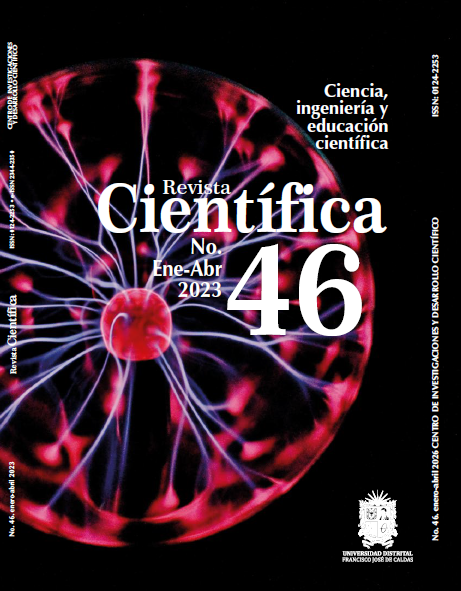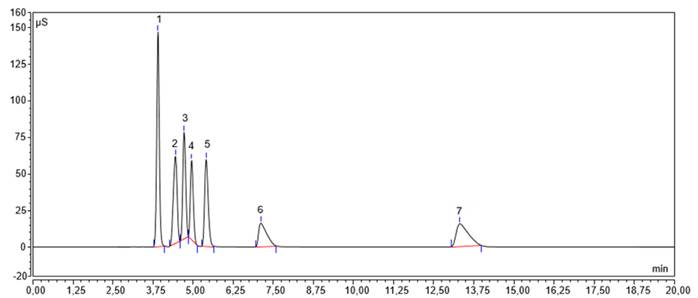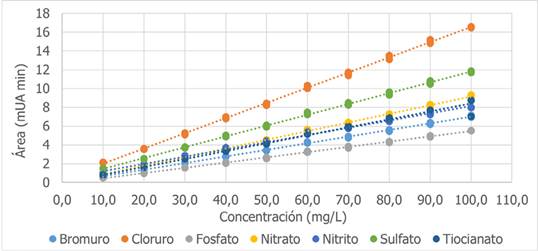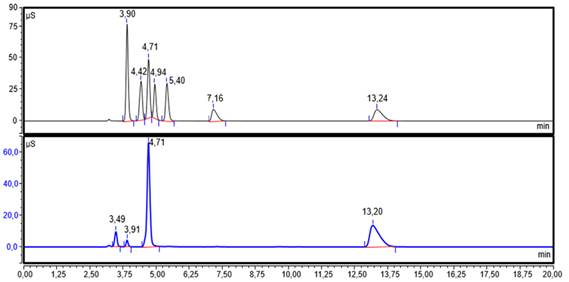DOI:
https://doi.org/10.14483/23448350.19427Published:
01/02/2023Issue:
Vol. 46 No. 1 (2023): January-April 2023Section:
Ciencias Básicas y EducaciónDesarrollo de un método analítico por cromatografía iónica para la cuantificación de aniones en aguas residuales de origen minero
Development of an Analytical Method by Ion Chromatography for the Quantification of Anions in Wastewater of Mining Origin
Keywords:
aguas residuales, cromatografía iónica, minería, sensibilidad, tiocianato, validación (es).Keywords:
ion chromatography, mining, sensitivity, thiocyanate, validation, wastewater (en).Downloads
References
Aguiar, J. B., Martins, A. M., Almeida, C., Ribeiro, H. M., Marto, J. (2022). Water sustainability: A waterless life cycle for cosmetic products. Sustainable Production and Consumption, 32, 35-51. https://doi.org/10.1016/j.spc.2022.04.008 DOI: https://doi.org/10.1016/j.spc.2022.04.008
Alvillo-Rivera, A., Garrido-Hoyos, S., Buitrón, G., Thangarasu-Sarasvathi, P., Rosano-Ortega, G. (2021). Biological treatment for the degradation of cyanide: A review. Journal of Materials Research and Technology, 12, 1418-1433. https://doi.org/10.1016/j.jmrt.2021.03.030 DOI: https://doi.org/10.1016/j.jmrt.2021.03.030
Amin, M., Lim, L. W., Takeuchi, T. (2008). Determination of common inorganic anions and cations by non-suppressed ion chromatography with column switching. Journal of Chromatography A, 1182(2), 169-175. https://doi.org/10.1016/j.chroma.2008.01.007 DOI: https://doi.org/10.1016/j.chroma.2008.01.007
APHA. (1998). Standard Methods for the Examination of Water and Wastewater. Washington DC: American Public Health Association
Budaev, S. L., Batoeva, A. A., Tsybikova, B. A. (2015). Degradation of thiocyanate in aqueous solution by persulfate activated ferric ion. Minerals Engineering, 81, 88-95. https://doi.org/10.1016/j.mineng.2015.07.010 DOI: https://doi.org/10.1016/j.mineng.2015.07.010
Cacace, D., Ashbaugh, H., Kouri, N., Bledsoe, S., Lancaster, S., Chalk, S. (2007). Spectrophotometric determination of aqueous cyanide using a revised phenolphthalin method. Analytica Chimica Acta, 589(1), 137-141. https://doi.org/10.1016/j.aca.2007.02.004 DOI: https://doi.org/10.1016/j.aca.2007.02.004
Causse, J., Thomas, O., Jung, A. V., Thomas, M. F. (2017). Direct DOC and nitrate determination in water using dual pathlength and second derivative UV spectrophotometry. Water Research, 108, 312-319. https://doi.org/10.1016/j.watres.2016.11.010 DOI: https://doi.org/10.1016/j.watres.2016.11.010
Chen, G., Ye, Y., Yao, N., Hu, N., Zhang, J., Huang, Y. (2021). A critical review of prevention, treatment, reuse, and resource recovery from acid mine drainage. Journal of Cleaner Production, 329, e129666. https://doi.org/10.1016/j.jclepro.2021.129666 DOI: https://doi.org/10.1016/j.jclepro.2021.129666
Da Silva, M., Fernandes Sako, A. V., Micke, G. A., Vitali, L. (2020). A rapid method for simultaneous determination of nitrate, nitrite and thiocyanate in milk by CZE-UV using quaternary ammonium chitosan as electroosmotic flow inverter. Journal of Food Composition and Analysis, 88, e103455. https://doi.org/10.1016/j.jfca.2020.103455 DOI: https://doi.org/10.1016/j.jfca.2020.103455
Destanoğlu, O., Gümüş Yılmaz, G. (2016). Determination of cyanide, thiocyanate, cyanate, hexavalent chromium, and metal cyanide complexes in various mixtures by ion chromatography with conductivity detection. Journal of Liquid Chromatography & Related Technologies, 39(9), 465-474. https://doi.org/10.1080/10826076.2016.1192044 DOI: https://doi.org/10.1080/10826076.2016.1192044
Destanoğlu, O., Gümüş Yılmaz, G., Apak, R. (2015). Selective determination of free cyanide in environmental water matrices by ion chromatography with suppressed conductivity detection. Journal of Liquid Chromatography & Related Technologies, 38(16), 1537-1545. https://doi.org/10.1080/10826076.2015.1076460 DOI: https://doi.org/10.1080/10826076.2015.1076460
Environment Protection Agency. (2018). Protocol for Review and Validation of New Methods for Regulated Organic and Inorganic Analytes in Wastewater Under EPA’s Alternate Test Procedure Program. Washington, DC: Office of Water, Environmental Protection Agency
Fa, Y., Yu, Y., Li, F., Du, F., Liang, X., Liu, H. (2018). Simultaneous detection of anions and cations in mineral water by two dimensional ion chromatography. Journal of Chromatography A, 1554, 123-127. https://doi.org/10.1016/j.chroma.2018.04.017 DOI: https://doi.org/10.1016/j.chroma.2018.04.017
Gómez-Ordóñez, E., Alonso, E., Rupérez, P. (2010). A simple ion chromatography method for inorganic anion analysis in edible seaweeds. Talanta, 82(4), 1313-1317. https://doi.org/10.1016/j.talanta.2010.06.062 DOI: https://doi.org/10.1016/j.talanta.2010.06.062
Gould, W. D., King, M., Mohapatra, B. R., Cameron, R. A., Kapoor, A., Koren, D. W. (2012). A critical review on destruction of thiocyanate in mining effluents. Minerals Engineering, 34, 38-47. https://doi.org/10.1016/j.mineng.2012.04.009 DOI: https://doi.org/10.1016/j.mineng.2012.04.009
He, X., Mei, Y., Wang, Y., Sun, W., Shen, M. (2019). Determination of inorganic anions in the whole blood by ion chromatography. Journal of Pharmaceutical and Biomedical Analysis, 163, 58-63. https://doi.org/10.1016/j.jpba.2018.09.030 DOI: https://doi.org/10.1016/j.jpba.2018.09.030
Ighalo, J. O., Kurniawan, S. B., Iwuozor, K. O., Aniagor, C. O., Ajala, O. J., Oba, S. N., Iwuchukwu, F. U., Ahmadi, S., Igwegbe, C. A. (2022). A review of treatment technologies for the mitigation of the toxic environmental effects of acid mine drainage (AMD). Process Safety and Environmental Protection, 157, 37-58. https://doi.org/10.1016/j.psep.2021.11.008 DOI: https://doi.org/10.1016/j.psep.2021.11.008
International Organization for Standardization. (2017). ISO/IEC 17025 - General requirements for the competence of testing and calibration laboratories
Kapinus, E. N., Revelsky, I. A., Ulogov, V. O., Lyalikov, Y. A. (2004). Simultaneous determination of fluoride, chloride, nitrite, bromide, nitrate, phosphate and sulfate in aqueous solutions at 10-9 to 10-8 % level by ion chromatography. Journal of Chromatography B, 800(1-2), 321-323. https://doi.org/10.1016/j.jchromb.2003.09.065 DOI: https://doi.org/10.1016/j.jchromb.2003.09.065
Langasco, I., Barracu, F., Deroma, M. A., Lopez-Sanchez, J. F., Mara, A., Meloni, P., Pilo, M. I., Estrugo, A. S., Sanna, G., Spano, N., Spanu, A. (2022). Assessment and validation of ICP-MS and IC-ICP-MS methods for the determination of total, extracted and speciated arsenic. Application to samples from a soil-rice system at varying the irrigation method. Journal of Environmental Management, 302(Pt B), e114105. https://doi.org/10.1016/j.jenvman.2021.114105 DOI: https://doi.org/10.1016/j.jenvman.2021.114105
Lim, H. S., Lee, S. J., Choi, E., Lee, S. B., Nam, H. S., Lee, J. K. (2022). Development and validation of an ionic chromatography method for nitrite determination in processed foods and estimation of daily nitrite intake in Korea. Food Chemistry, 382, e132280. https://doi.org/10.1016/j.foodchem.2022.132280 DOI: https://doi.org/10.1016/j.foodchem.2022.132280
Luque-Almagro, V. M., Moreno-Vivian, C., Roldán, M. D. (2016). Biodegradation of cyanide wastes from mining and jewellery industries. Current Opinion in Biotechnology, 38, 9-13. https://doi.org/10.1016/j.copbio.2015.12.004 DOI: https://doi.org/10.1016/j.copbio.2015.12.004
Mahmud, M. A. P., Ejeian, F., Azadi, S., Myers, M., Pejcic, B., Abbassi, R., Razmjou, A., Asadnia, M. (2020). Recent progress in sensing nitrate, nitrite, phosphate, and ammonium in aquatic environment. Chemosphere, 259, e127492. https://doi.org/10.1016/j.chemosphere.2020.127492 DOI: https://doi.org/10.1016/j.chemosphere.2020.127492
Miskaki, P., Lytras, E., Kousouris, L., Tzoumerkas, P. (2007). Data quality in water analysis: Validation of ion chromatographic method for the determination of routine ions in potable water. Desalination, 213(1-3), 182-188. https://doi.org/10.1016/j.desal.2006.05.063 DOI: https://doi.org/10.1016/j.desal.2006.05.063
Talebi, S. M., Abedi, M. (2005). Determination of atmospheric concentrations of inorganic anions by ion chromatography following ultrasonic extraction. Journal of Chromatography A, 1094(1-2), 118-121. https://doi.org/10.1016/j.chroma.2005.07.118 DOI: https://doi.org/10.1016/j.chroma.2005.07.118
Thangiah, A. S. (2019). Spectrophotometric determination of sulphate and nitrate in drinking water at Asia-Pacific International University Campus, Muak Lek, Thailand. Rasayan Journal of Chemistry, 12(03), 1503-1508 DOI: https://doi.org/10.31788/RJC.2019.1235201
Uzhel, A. S., Zatirakha, A. V., Smolenkov, A. D., Shpigun, O. A. (2018). Quantification of inorganic anions and organic acids in apple and orange juices using novel covalently-bonded hyperbranched anion exchanger with improved selectivity. Journal of Chromatography A, 1567, 130-135. https://doi.org/10.1016/j.chroma.2018.06.065 DOI: https://doi.org/10.1016/j.chroma.2018.06.065
Ye, M., Nesterenko, P. N., Yan, Z., Xie, P., Chen, M. (2019). Determination of inorganic anions in weak acids by using ion exclusion chromatography - Capillary ion chromatography switching column technique. Journal of Chromatography A, 1588, 169-173. https://doi.org/10.1016/j.chroma.2019.01.007 DOI: https://doi.org/10.1016/j.chroma.2019.01.007
Zhou, M., Li, X., Zhang, M., Liu, B., Zhang, Y., Gao, Y., Ullah, H., Peng, L., He, A., Yu, H. (2020). Water quality in a worldwide coal mining city: A scenario in water chemistry and health risks exploration. Journal of Geochemical Exploration, 213, e106513. https://doi.org/10.1016/j.gexplo.2020.106513 DOI: https://doi.org/10.1016/j.gexplo.2020.106513
How to Cite
APA
ACM
ACS
ABNT
Chicago
Harvard
IEEE
MLA
Turabian
Vancouver
Download Citation
Recibido: de julio de 2022; Aceptado: de diciembre de 2022
Resumen
El objetivo de este trabajo fue desarrollar un método por cromatografía iónica con detector de conductividad para la determinación simultánea de tiocianato en aguas residuales mineras y aniones como bromuro, cloruro, fluoruro, fosfato, nitrito, nitrato y sulfato. Como eluente se utilizó hidróxido de potasio (KOH) en un rango de concentraciones entre 20,0 y 27,0 mM , flujos entre 0,4 y 1,2 mL min-1 y corriente del supresor entre 50,0 y 70,0 mA. Se determinó que la mejor separación de las especies estudiadas se logró con una concentración de KOH de 21,9 mM en modo isocrático y un flujo de 1,0 mL min-1 en una columna analítica AS20. Además, se determinó una serie de parámetros analíticos como sensibilidad, linealidad, precisión, exactitud y límites de detección y cuantificación que permiten la validación del método analítico. Se obtuvieron valores de desviación estándar relativa (RSD) menores al 20 % en cuanto a la precisión del método analítico, con recuperaciones mayores al 96 %. El método desarrollado es por lo tanto adecuado para la determinación de tiocianato y aniones en aguas residuales de origen minero.
Palabras clave:
aguas residuales, cromatografía iónica, minería, sensibilidad, tiocianato, validación..Abstract
The objective of this work was to develop a method by ion chromatography with conductivity detector for the simultaneous determination of thiocyanate in mining wastewater and anions such as bromide, chloride, fluoride, phosphate, nitrite, nitrate and sulfate. Potassium hydroxide (KOH) was used as an eluent in a range of concentrations between 20,0 y 27,0 mM, flows between 0,4 y 1,2 mL min-1 and suppressor current between 50,0 y 70,0 mA. It was determined that the best separation of the species was achieved with a KOH concentration of 21,9 mM in isocratic mode and a flow of 1,0 mL min-1 in an AS20 analytical column. In addition, a series of analytical parameters such as sensitivity, linearity, precision, accuracy and limits of detection and quantification were determined that allow the validation of the analytical method. Relative standard deviation (RSD) values of less than 20 % were obtained in terms of the accuracy of the analytical method, with recoveries greater than 96 %. The method developed is therefore suitable for the determination of thiocyanate and anions in wastewater of mining origin.
Keywords:
ion chromatography, mining, sensitivity, thiocyanate, validation, wastewater..Resumo
O objetivo deste trabalho foi desenvolver um método por cromatografia de íon com detector de condutividade para a determinação simultânea de tiocianato em águas residuais de mineração e ânions como brometo, cloreto, flúor, fosfato, nitrito, nitrato e sulfato. O hidróxido de potássio (KOH) foi usado como eluente em uma faixa de concentrações entre 20,0 y 27,0 mM, flui entre 0,4 y 1,2 mL min-1 e corrente supressora entre 50,0 y 70,0 mA. Foi determinado que a melhor separação da espécie foi alcançada com uma concentração KOH de 21,9 mM em modo isocrático e um fluxo de 1,0 mL min-1 em uma coluna analítica AS20. Além disso, foram determinados uma série de parâmetros analíticos como sensibilidade, linearidade, precisão, precisão e limites de detecção e quantificação que permitem a validação do método analítico. Valores de desvio padrão relativo (RSD) inferiores a 20 % foram obtidos em termos de precisão do método analítico, com recuperações superiores a 96 %. O método desenvolvido é, portanto, adequado para a determinação de tiocianato e ânions em águas residuais de origem mineira.
Palavras-chaves:
águas residuais, cromatografia de íons, mineração, sensibilidade, tiocianato, validação.Introducción
El agua es el recurso más preciado de la Tierra, regula los ecosistemas, preserva la calidad ambiental y sustenta la vida. Sin embargo, el crecimiento de la población, la urbanización, la industrialización, la expansión, la intensificación de la agricultura y el cambio climático han producido una contaminación paulatina del agua dulce (Aguiar et al., 2022; Zhou et al., 2020).
El proceso de extracción de minerales metálicos está dando como resultado un desequilibrio a nivel ambiental. La adición de químicos, la molienda y la trituración de muchos minerales aumentan su área superficial y su exposición a la intemperie produce que se combinen fácilmente con el oxígeno y los cuerpos de agua circundantes. A partir de este proceso, se originan ácidos y altas concentraciones de metaloides que causan impactos ambientales perjudiciales en cuerpos de agua, suelos y organismos vivos (Chen et al., 2021; Ighalo et al., 2022).
La gran mayoría del oro que se produce anualmente en todo el mundo se extrae con técnicas de lixiviación con cianuro. Los molinos que se utilizan para extraer cianuro y plata producen mezclas de cianuro y tiocianato en sus efluentes, haciéndolos tóxicos. El tiocianato se produce cuando el cianuro reacciona con minerales sulfurados del suelo. El tiocianato formado es más estable y por lo tanto más difícil de degradar (Budaev, Batoeva y Tsybikova, 2015).
Aproximadamente 875 operaciones de extracción de oro y plata existen en el mundo, de las cuales 460 (52 % de la industria metalúrgica) utilizan cianuro en sus procesos. Este uso del cianuro está asociado a procesos hidrometalúrgicos (Alvillo-Rivera et al., 2021; Luque, Moreno y Roldan, 2016).
Los iones de nutrientes como el nitrato, el nitrito, el fosfato y el amonio son una parte esencial de la industria agrícola y desempeñan un papel fundamental en el sostenimiento de las criaturas vivas en los ecosistemas acuáticos. El nivel elevado de nutrientes en las aguas naturales puede tener consecuencias ambientales tales como mayor crecimiento y eutrofización del fitoplancton, mayor turbidez del agua y disminución de los nutrientes disueltos.
Como resultado de lo anterior es necesario investigar en el desarrollo de métodos analíticos para el monitoreo continuo de las concentraciones de especies químicas en ambientes acuáticos de manera oportuna, brindando así información valiosa que puede usarse para guiar el uso sostenible y la remediación de los ecosistemas. El monitoreo preciso de ecosistemas ambientales acuáticos juega un papel de vital importancia en la mejora de la calidad de vida humana a través del rastreo de químicos potencialmente tóxicos, el análisis de contaminantes y la posterior eliminación de estos por procesos de degradación (Mahmud et al., 2020).
Muchos métodos diferentes han sido reportados en la literatura para el análisis de cationes, aniones y metales en agua y en diferentes matrices. Métodos volumétricos, gravimétricos, colorimétricos y espectrofotométricos están entre los más utilizados (Cacace et al., 2007; Causse et al., 2017; Thangiah, 2019). La espectrofotometría de absorción atómica de llama se ha utilizado tradicionalmente para la determinación de cationes. En cuanto a los aniones, se han desarrollado muchos métodos que, en la mayoría de los casos, son específicos para el análisis por separado de cada uno. La Asociación Estadounidense de Salud Pública definió métodos individuales, que se han utilizado tradicionalmente, para la determinación de cloruro, fluoruro, nitrato, sulfato y fósforo en el agua (APHA, 1998). Desde entonces ha habido muchos esfuerzos para mejorar la utilización de estos métodos.
La cromatografía iónica se usa ampliamente para la determinación de aniones y cationes con ventajas que incluyen determinación simultánea y rápida de muchos aniones en una sola ejecución cromatográfica, alta sensibilidad y alta selectividad en muestras con matrices complejas. Básicamente, los aniones y cationes se separaron de forma independiente utilizando métodos de supresión iónica con detectores de conductividad y amperométricos (Amin, Lim y Takeuchi, 2008; Gómez-Ordóñez, Alonso y Rupérez, 2010). Entre las matrices más estudiadas se encuentran: agua (Destanoğlu, Gümüş Yılmaz y Apak, 2015; Fa et al., 2018; Kapinus et al., 2004; Miskaki et al., 2007), sangre (He et al., 2019), leche (da Silva et al., 2020), algas (Gómez-Ordóñez et al., 2010), impurezas de ácidos débiles (Ye et al., 2019), jugos naturales de manzana (Uzhel et al., 2018), alimentos (Lim et al., 2022), atmósfera (Talebi y Abedi, 2005) y suelos (Langasco et al., 2022).
En el presente estudio se desarrolló un método analítico por cromatografía iónica con detector de conductividad para la determinación simultanea de iones bromuro (), cloruro (), fosfato (), nitrato (), nitrito (), sulfato () y tiocianato () en matrices de aguas residuales mineras. Se determinaron los parámetros de validación fundamentales para analizar el método desde el punto de vista de sensibilidad, repetibilidad y reproducibilidad.
Metodología
Reactivos químicos
Los estándares de bromuro de sodio, cloruro de sodio, fosfato monobásico de potasio, nitrato de sodio, nitrito de sodio, sulfato de sodio y tiocianato de sodio fueron Sigma Aldrich. El agua empleada fue tipo I obtenida mediante un sistema de purificación Direct-Q.
Muestra de estudio
El agua residual se obtuvo de dos minas ubicadas en el Municipio de Marmato (Caldas Colombia), región caracterizada por la alta explotación minera ubicada a una altura de 1.310 msnm y a una distancia de 90,4 km de Manizales (capital del departamento de Caldas).
Preparación de la muestra
Las muestras de agua de mina fueron almacenadas en refrigeración a 4,0º C hasta el momento de su análisis. Antes de ser inyectadas al cromatógrafo, las muestras fueron filtradas para eliminar partículas mayores a 0,45 µm y posteriormente diluidas con agua tipo I en una relación de 1:10.
Condiciones cromatográficas
El análisis cromatográfico de los aniones se realizó en un cromatógrafo de intercambio iónico Thermo Scientific, con bomba Dionex ICS-5000, generador de eluente Dionex ICS-5000, automuestreador Dionex AS-AP, detector de conductividad Dionex ICS-5000 y columna Dionex IonPac AS20 (4 x 250 mm). El software empleado para el análisis de los datos fue Chromeleon versión 7.2.
Para obtener las condiciones óptimas de separación, se inyectaron alternadamente muestras de agua de mina y mezclas de estándares que contenían iones bromuro (), cloruro (), fosfato (), nitrato (), nitrito (), sulfato () y tiocianato (), empleando un sistema de detección de celda conductimétrica a 30º C. La preparación del eluente (KOH) se realizó de forma automática mediante generación electroquímica a concentraciones entre 20,0 y 27,0 mM en modo isocrático, con flujos que variaron desde 0,4 mL min-1 hasta 1,2 mL min-1. Con la finalidad de disminuir la línea base se empleó un supresor electrolítico aniónico (Dionex ADRS, 4 mm) con corrientes que variaron entre 50,0 y 70,0 mA.
Recta de calibración
La recta de calibración fue elaborada con una mezcla de siete estándares de aniones, a diez niveles con concentración: 10,0, 20,0, 30,0, 40,0, 50,0, 60,0, 70,0, 80,0, 90,0 y 100,0 mg L-1. Las soluciones fueron preparadas al disolver los estándares en agua tipo I. Para conocer la relación existente entre la señal instrumental en términos de área y la concentración en mg L-1 de los aniones, se realizó una regresión lineal simple por el método de mínimos cuadrados ordinarios y se verificaron los supuestos de normalidad, homocedasticidad e independencia, esto con el fin de validar la información aportada por el ANOVA paramétrico de la regresión. De cada punto de la curva se hicieron tres réplicas, para un total de 30 datos por analito.
Parámetros analíticos
Para determinar la potencia del método analítico se determinaron los parámetros: sensibilidad, linealidad, precisión, exactitud y límites de detección y cuantificación, como lo describe el protocolo de validación de analitos para aguas residuales (EPA, 2018)
Análisis estadístico de los datos
Los análisis fueron realizados mediante el software libre RStudio versión 1.3.1093. Para la cuantificación de aniones presentes en las muestras problema se realizó una curva de calibración con estándar externo. A dicha curva de calibración (modelo de regresión lineal), se le comprobaron los supuestos de normalidad (Shapiro-Wilks), homocedasticidad (Bartlett) e independencia (Durbin-Watson), con el fin de tener seguridad sobre los resultados que arrojó dicha curva.
Resultados
Condiciones cromatográficas
Se demostró que la columna analítica AS20 es adecuada para la separación de los aniones estudiados. Entre las concentraciones de eluente ensayadas, la mejor separación se obtuvo a en modo isocrático a un flujo de durante 20,0 min. La corriente del supresor fue proporcional a la concentración del eluente, concretamente . La temperatura de columna y el volumen de inyección fueron de 30º C y 25 μL respectivamente. Se han reportado en la literatura separaciones de aniones por cromatografía iónica de efluentes de agua residual industrial, utilizando modo gradiente con NaOH como eluente variando su concentración entre y en corriente del supresor (Destanoğlu y Gümüş Yılmaz, 2016). En la Figura 1 se muestra un cromatograma con la separación de los siete aniones analizados empleando las condiciones descritas anteriormente.
Figura 1: Cromatograma de siete aniones: 1. cloruro, 2. nitrito, 3. sulfato, 4. bromuro, 5. nitrato, 6. fosfato y 7. Tiocianato.
Bajo las condiciones óptimas, el método proporcionó picos cromatográficos bien definidos con valores de resolución superiores a 1,4. La Tabla 1 resume los tiempos de retención y su repetibilidad en términos de desviación estándar relativa de los aniones estudiados, mostrando buena repetibilidad en la elución de estos analitos con valores inferiores a 0,103 %.
Tabla 1: Repetibilidad de los tiempos de retención bajo las condiciones óptimas del método cromatográfico.

Recta de calibración
Para encontrar el mejor ajuste lineal para cada analito, se realizó el análisis de regresión, teniendo en cuenta todas las réplicas por cada nivel de concentración y no sus promedios; obteniéndose mayor información sobre el fenómeno real, es decir, sobre el comportamiento que presenta la señal instrumental, debido a la variación en la concentración (Figura 2); aunque esto conlleve a una posible disminución en el coeficiente de determinación de la regresión, garantizando que no se pierda información relevante para el análisis de varianza y para el posterior análisis de algunos parámetros de la validación.
Figura 2: Recta de calibración del método de cuantificación para siete aniones.
El supuesto de normalidad fue verificado mediante la prueba Shapiro-Wilk (P-valor 0,657) indicando que los residuos tienen una distribución normal. El supuesto de independencia se verificó mediante la correlación entre datos. La verificación de la homocedasticidad se realizó mediante la prueba de Bartlett (p-valor 0,075) indicando que, las varianzas de la señal para los diferentes niveles de concentración son iguales. Todos los supuestos fueron trabajados con una significancia del 5 %. A partir de esta información se infiere que el modelo obtenido de la recta sirve para determinar la concentración de los aniones en muestras de agua de mina, si estas se encuentren en el rango de concentración propuesto.
El análisis de varianza permitió verificar que existía una relación significativa entre el área de pico y la concentración, con una significancia del 5 % (p-valor < 0,015). Por lo tanto, se determinaron los parámetros de los modelos con sus respectivas desviaciones estándar, al igual que los coeficientes de determinación del análisis de la regresión (Tabla 2).
Tabla 2: Análisis de regresión de siete aniones.

Parámetros de validación
Límite de detección y límite de cuantificación
El límite de detección (LOD) del método para cada anión fue determinado matemáticamente empleando la ecuación (LOD)= 2 *t 0.05;n-2 * S0 , donde S0 es la desviación estándar de la concentración predicha para una muestra blanco y n es el número total de puntos de la recta de calibrado por analito. El límite de cuantificación (LOQ) corresponde a 10 veces la desviación estándar del blanco (LOQ=10 * S0). Con base en estas ecuaciones se obtiene que los LOD para los siete aniones son inferiores a 9,73 mg L-1 y los LOQ son inferiores a 23,74 mg L-1.
Sensibilidad de calibrado
La sensibilidad de calibrado (Sc) corresponde a la pendiente de la curva de calibración (β1) utilizada para la cuantificación (Sc = β1). Se realizó una prueba de hipótesis para determinar si existía una relación entre la variación de la señal a medida que cambia la concentración de analito. Se rechazó la hipótesis nula, es decir, la pendiente de la recta de calibrado es diferente de 0 con una significancia del 5 % (p-valor < 0,001).
Sensibilidad analítica
La sensibilidad analítica (γ) es definida por la relación entre la sensibilidad de calibrado y el ruido instrumental (Sy) (γ = Sc / Sy . La sensibilidad analítica del método cromatográfico es un parámetro que permite realizar comparaciones entre diferentes métodos de análisis. Para hacer más fácil la comparación entre métodos se decidió obtener el inverso de la sensibilidad analítica (γ-1), la cual presentó valores inferiores a 3,72 mg L-1, lo que indica que para la técnica analítica utilizada en 1,0 L de muestra, la mínima cantidad de analito que puede apreciarse es de 3,72 mg.
Rango lineal
La manera como se midió el cumplimiento del rango lineal es a través de la prueba de carencia de ajuste, la cual se determinó a partir de una prueba F. Se calculó en primera medida el valor experimental de la prueba F, el cual está dado por la FEXP=(Sy/x)2/(SY)2 donde FEXP hace referencia a la carencia de ajuste del modelo y Sy/x es la desviación estándar debido a la falta de ajuste en el modelo de regresión. Las variables de la prueba F fueron determinadas a partir de la recta de calibración. En ninguna de las curvas de calibrado se pudo rechazar la hipótesis nula (FEXP ?λτ; F), es decir, no hacen falta términos de orden superior en ninguno de los modelos y por ende los datos se comportan linealmente desde su límite de cuantificación hasta su máxima concentración evaluada (100,0 mg L-1), con una significancia del 5 %.
En la Tabla 3 se resumen las cifras de mérito evaluadas para cada uno de los siete aniones analizados mediante el método cromatográfico óptimo.
Tabla 3: Parámetros de validación.

Precisión
La precisión intradiaria e interdiaria se evaluó a tres mismos niveles de concentración: bajo (20,0 mg L-1), medio (50,0 mg L-1) y alto (70,0 mg L-1). La precisión intradiaria (repetibilidad) se evaluó mediante el análisis de estándares que fueron analizadas durante el mismo día por el mismo analista y en el mismo instrumento. La precisión intradía se determinó en términos de la desviación estándar relativa (RSD) de cinco réplicas para cada nivel de concentración. La precisión interdía (intermedia) fue expresada por la RSD de los resultados de dieciocho réplicas realizadas en tres días sucesivos (seis análisis por día para cada nivel de concentración), que fueron realizadas por el mismo analista y en el mismo instrumento. Los resultados obtenidos se presentan en la Tabla 4.
Tabla 4: Resultados de las precisiones intradiarias e interdiarias a tres niveles de concentración.
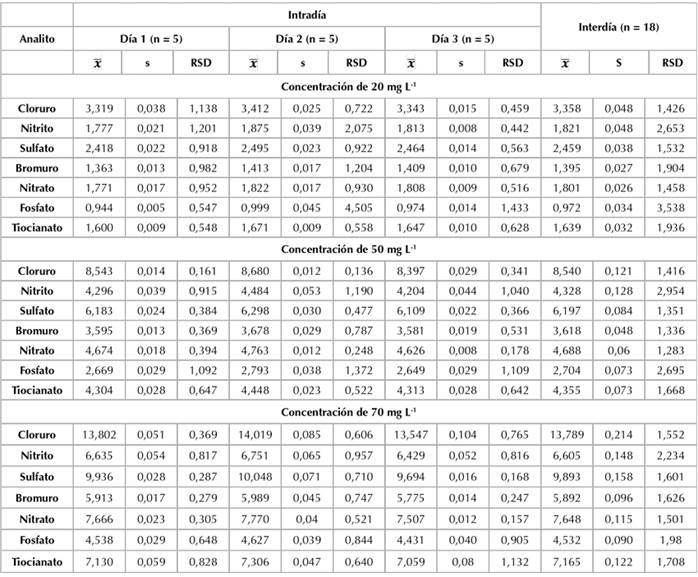
De esta manera, se afirma de acuerdo con los resultados obtenidos que el método cuantitativo es preciso, dado que en todos los niveles de concentración donde se evaluó la precisión, la desviación estándar relativa fue menor al 20,0 % (EPA, 2018; ISO, 2017).
Exactitud
Este parámetro se determinó mediante el porcentaje de recuperación a nivel bajo (20,0 mg L-1), medio (50,0 mg L-1) y alto (70,0 mg L-1), según la concentración presentada por la muestra.
El porcentaje de recuperación a los diferentes niveles de concentración de los analitos se calculó a partir de la ecuación 1, donde S corresponde al Spike o concentración de analito adicionado a la muestra, C es la concentración de analito en la muestra y CS es la concentración de analito después del dopaje. Los resultados así obtenidos se presentan en la Tabla 5.

Tabla 5: Porcentajes de recuperación en los niveles de dopaje empleados.

Se efectuó un ANOVA paramétrico simple estableciendo que no hay diferencias estadísticamente significativas entre los tres niveles de concentración evaluados con una significancia del 5 %, previa verificación de los supuestos de normalidad, independencia y homocedasticidad de los datos. Los porcentajes de recuperación obtenidos a los diferentes niveles de concentración fueron similares entre ellos, pero las desviaciones estándar a niveles de concentración medio y alto son mayores, por lo tanto, se recomienda para este tipo de análisis dopajes a niveles bajos de concentración.
Análisis de muestras
El método desarrollado de cromatografía iónica se utilizó para la cuantificación de aniones en dos muestras de agua de mina, buscando someter a prueba la sensibilidad del método analítico. En la Figura 3 se pueden observar un cromatograma de los estándares de aniones y un cromatograma de una de las muestras de agua de mina, los cuales demuestran que en la muestra podemos encontrar cloruro (tr = 3,91 min), sulfato (tr = 4,71 min) y tiocianato (tr = 13,24 min).
Figura 3: Cromatogramas de estándares de aniones y de muestras de agua de mina.
Por otro lado, se realizó un ANOVA simple paramétrico y la prueba de múltiples rangos de Tukey para determinar diferencias en las concentraciones de aniones en las muestras de estudio, encontrando que son distintas con una significancia del 5 % (p-valor < 0,0001), obteniéndose mayor concentración de cloruro, sulfato y tiocianato en la mina 1 (Tabla 6).
Tabla 6: Concentración de aniones de dos minas del municipio de Marmato.

Se observa una concentración alta de tiocianato y sulfato en la mina 1 superior a los 1.000 mg L-1. Esto es característico de aguas residuales de origen minero que utilizan cianuro como base para realizar extracción de oro. Por el momento no hay una regulación de los valores permitidos de SCN- en aguas residuales mineras, sin embargo, en la literatura se reportan concentraciones de descarga menores a 150 mg L-1 (Gould et al., 2012).
Conclusiones
Se presenta un método rápido por cromatografía iónica con detector de conductividad para la determinación simultánea de tiocianato y aniones bromuro, cloruro, fluoruro, fosfato, nitrito, nitrato y sulfato. El método desarrollado es confiable, preciso, selectivo, sensible y adecuado para el análisis de muestras de agua residual de origen minero. Se obtuvieron recuperaciones aceptables y valores de desviación estándar relativa (RSD) acordes a los métodos de validación estipulados por la EPA (Environment Protection Agency) tanto en soluciones estándar como en muestras reales. Se obtuvieron valores altos de tiocianato en las aguas de mina analizadas, este es característico de procesos de extracción de oro con cianuro.
Acknowledgements
Agradecimientos
Los autores agradecen a la Vicerrectoría de Investigaciones y Posgrados de la Universidad de Caldas por el financiamiento del proyecto 0744119 titulado “Eficiencia de reactores de biopelícula de lecho fijo sumergido y de lecho móvil para el tratamiento de aguas residuales de origen minero”.
Referencias
License
Copyright (c) 2023 Julio-Andrés Cardona-Castaño, Juan-David Rivera-Giraldo, Fernando-Antonio Chávez-Vallejo

This work is licensed under a Creative Commons Attribution-NonCommercial-ShareAlike 4.0 International License.
When submitting their article to the Scientific Journal, the author(s) certifies that their manuscript has not been, nor will it be, presented or published in any other scientific journal.
Within the editorial policies established for the Scientific Journal, costs are not established at any stage of the editorial process, the submission of articles, the editing, publication and subsequent downloading of the contents is free of charge, since the journal is a non-profit academic publication. profit.

